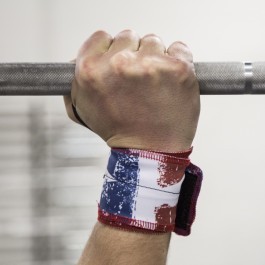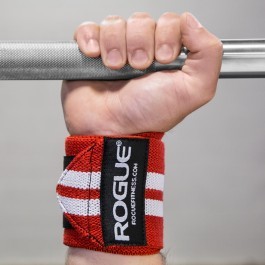How to Deal with a Common CrossFit Injury: The Wrist

Look around a CrossFit gym, or “box,” and you’ll see athletes of all fitness level performing push-ups, pull-ups, ring dips, heavy lifts, and an assortment of other impressive exercises.
What may not be completely obvious to an onlooker is the incredible amount of strain being put on the wrists in just about every CrossFit exercise. While other sports may also strain the wrists, CrossFit athletes are at a higher risk for wrist injury just based on the nature of the sport.
The ability to lift heavy weights depends on strong, healthy wrists. Lifts that involve a backward extension of the wrists create an incredible amount of unnatural strain, which could eventually lead to injury and long-term damage. Body weight exercises like ring dips, pull-ups, and push-ups also strain the wrists as they are supporting the weight of the body or helping pull the body up.
https://www.youtube.com/watch?v=l5h_nrG614U
I’m definitely not suggesting taking the easy route and avoiding high impact workouts. Working out, staying fit, and achieving physical fitness goals is extremely healthy, both for the body and the mind. To mitigate potential injuries and continue exercising for as long as possible, I strongly recommend that CrossFit beginners and those athletes without a solid foundation work with a trainer, lift weights that are comfortable but still challenging, and build up slowly. That way, your body will be conditioned and ready to tackle higher weights and achieve personal bests.
While wrist wraps may not completely prevent injury, they can lend extra support to the wrist. This is not to say that wrist wraps can replace foundational training or basic conditioning – they are mainly meant to be a tool.
[box type="shadow" align="aligncenter" class="" width=""] 3 Common Types of Wrist Wraps
[one_third] [/one_third][one_third]
[/one_third][one_third] [/one_third][one_third_last]
[/one_third][one_third_last] [/one_third_last][/box]
[/one_third_last][/box]
Most CrossFit gym owners and coaches will take the time to demonstrate how to wrap their wrists, and should be able to educate on the different types and their primary uses. For more information, see our infographic for types of wrist wraps.

If you do sustain a wrist injury and it isn't treated right away, it can lead to chronic wrist arthritis, which may stop you from participating in CrossFit altogether. Brad Chase summed it up perfectly in his blog:
The biggest takeaway here should be that if you have injured your wrist, have it addressed sooner rather than later. If you want to have any chance of continuing CrossFit in the future, seek an early diagnosis by a trained orthopedic physician.

Remember, there is a significant difference between injury and exercise-induced soreness. Injuries left untreated can cause serious, long-term health problems like chronic pain and severe disability. If you’re experiencing pain that is persistent and is more than mild discomfort, see your doctor to get it evaluated and follow their advice for when you can return to CrossFit.
[box type="warning" align="aligncenter" class="" width=""]The advice and information contained in this article is for educational purposes only, and is not intended to replace or counter a physician’s advice or judgment. Please always consult your physician before taking any advice learned here or in any other educational medical material.[/box]
Dr. Philip To is the Hand and Upper Extremity Specialist at Arizona Bone & Joint Specialists.
Originally from Toledo, Ohio, Dr. To completed his undergraduate degree at OSU, his residency at Vanderbilt University, and his fellowship training at the Mary S. Stern Hand Fellowship in Cincinnati, Ohio.
To’s fascination with the meticulous detail and precision required for upper extremity orthopedic surgery inspired him to pursue the specialty. When he is not helping patients or performing surgeries, Dr. To enjoys traveling, cooking, and watching Ohio State Football. Go Buckeyes!
Learn more about Dr. To and his fellow orthopedic surgeons at AZ Bone , Twitter , and Facebook.
What may not be completely obvious to an onlooker is the incredible amount of strain being put on the wrists in just about every CrossFit exercise. While other sports may also strain the wrists, CrossFit athletes are at a higher risk for wrist injury just based on the nature of the sport.
A Common CrossFit Injury: The Wrist
The ability to lift heavy weights depends on strong, healthy wrists. Lifts that involve a backward extension of the wrists create an incredible amount of unnatural strain, which could eventually lead to injury and long-term damage. Body weight exercises like ring dips, pull-ups, and push-ups also strain the wrists as they are supporting the weight of the body or helping pull the body up.
https://www.youtube.com/watch?v=l5h_nrG614U
I’m definitely not suggesting taking the easy route and avoiding high impact workouts. Working out, staying fit, and achieving physical fitness goals is extremely healthy, both for the body and the mind. To mitigate potential injuries and continue exercising for as long as possible, I strongly recommend that CrossFit beginners and those athletes without a solid foundation work with a trainer, lift weights that are comfortable but still challenging, and build up slowly. That way, your body will be conditioned and ready to tackle higher weights and achieve personal bests.
Gear Talk: Understanding Wrist Wraps
While wrist wraps may not completely prevent injury, they can lend extra support to the wrist. This is not to say that wrist wraps can replace foundational training or basic conditioning – they are mainly meant to be a tool.
[box type="shadow" align="aligncenter" class="" width=""] 3 Common Types of Wrist Wraps
[one_third]
 [/one_third][one_third]
[/one_third][one_third] [/one_third][one_third_last]
[/one_third][one_third_last] [/one_third_last][/box]
[/one_third_last][/box]Most CrossFit gym owners and coaches will take the time to demonstrate how to wrap their wrists, and should be able to educate on the different types and their primary uses. For more information, see our infographic for types of wrist wraps.

What to do after a Wrist Injury?
If you do sustain a wrist injury and it isn't treated right away, it can lead to chronic wrist arthritis, which may stop you from participating in CrossFit altogether. Brad Chase summed it up perfectly in his blog:
The first step on the road to recovery is admitting that there may in fact be a problem.
The biggest takeaway here should be that if you have injured your wrist, have it addressed sooner rather than later. If you want to have any chance of continuing CrossFit in the future, seek an early diagnosis by a trained orthopedic physician.

Signs of a serious wrist injury include:
- Stabbing, aching, or dull pain in the wrist
- Hearing or feeling a snapping or popping followed by pain
- Swelling or inflammation of surrounding muscles
- Bruising around your wrists, arms or hands
- Pain that persists
- Weak grip while holding objects, like a coffee cup
Remember, there is a significant difference between injury and exercise-induced soreness. Injuries left untreated can cause serious, long-term health problems like chronic pain and severe disability. If you’re experiencing pain that is persistent and is more than mild discomfort, see your doctor to get it evaluated and follow their advice for when you can return to CrossFit.
[box type="warning" align="aligncenter" class="" width=""]The advice and information contained in this article is for educational purposes only, and is not intended to replace or counter a physician’s advice or judgment. Please always consult your physician before taking any advice learned here or in any other educational medical material.[/box]
 Author Bio:
Author Bio:
Dr. Philip To is the Hand and Upper Extremity Specialist at Arizona Bone & Joint Specialists.
Originally from Toledo, Ohio, Dr. To completed his undergraduate degree at OSU, his residency at Vanderbilt University, and his fellowship training at the Mary S. Stern Hand Fellowship in Cincinnati, Ohio.
To’s fascination with the meticulous detail and precision required for upper extremity orthopedic surgery inspired him to pursue the specialty. When he is not helping patients or performing surgeries, Dr. To enjoys traveling, cooking, and watching Ohio State Football. Go Buckeyes!
Learn more about Dr. To and his fellow orthopedic surgeons at AZ Bone , Twitter , and Facebook.




































































































